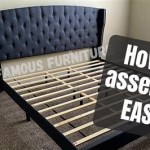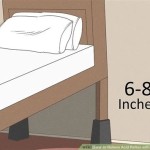How To Turn A Twin Bed Into A Queen
Creating a larger sleeping space from two twin beds offers a practical solution for guests, growing families, or those seeking more room without purchasing a new bed frame. This process involves combining two twin beds to simulate the dimensions of a standard queen-sized bed. While it may seem simple, several key steps ensure a comfortable and stable sleeping surface.
Choosing the Right Twin Beds
The foundation of a successful twin-to-queen conversion relies heavily on the types of twin beds being used. Ideally, two identical twin XL beds are recommended. Twin XL beds possess the same width as standard twins but offer an additional five inches in length. Combining two twin XL beds results in the exact dimensions of a standard queen mattress (60 inches wide by 80 inches long). Using two standard twin beds creates a slightly shorter sleeping surface, potentially unsuitable for taller individuals.
Beyond size, bed type matters considerably. Matching box springs and mattresses are preferred to minimize height discrepancies and movement. While it's possible to combine different bed types, doing so may lead to an uneven sleeping surface or create a noticeable gap between the two mattresses, impacting overall comfort. If using existing beds, ensuring they are in good condition, with sturdy frames and supportive mattresses and box springs, is essential.
Connecting the Beds Seamlessly
Once suitable twin beds are selected, the next step is joining them together securely. Begin by positioning the beds side by side in the desired location. The primary goal is to create a single, unified sleeping surface. Several methods achieve this, each with its own advantages.
One common approach involves using specialized bed connectors or bridge clips. These devices, readily available at most furniture retailers, clasp onto the bed frames, creating a tight connection between the two beds. They effectively minimize movement and shifting, crucial for a comfortable night's sleep.
Another effective technique utilizes ratchet straps. Wrapping ratchet straps around the frames of both beds and tightening them securely creates a firm bond, preventing separation. This method provides a reliable and cost-effective solution.
Regardless of the chosen method, ensuring a tight fit between the two beds is paramount. Any significant gaps can lead to discomfort and disrupt sleep. Careful positioning and secure fastening are essential for a successful conversion.
Creating a Unified Mattress Surface
With the frames securely connected, the focus shifts to the mattresses. The objective is to create a smooth, even surface, eliminating the noticeable divide between the two twin mattresses. This can be achieved using several strategies.
A queen-sized mattress topper provides a simple and effective solution. Placed over the joined twin mattresses, the topper creates a seamless sleeping surface, concealing the gap between the two. Memory foam toppers are particularly well-suited for this purpose, as they conform to the body, further enhancing comfort and minimizing movement transfer.
Another option involves using a queen-sized mattress pad or fitted sheet. While this method effectively covers the gap, it may not fully address the potential for movement between the mattresses. In this case, placing a blanket or comforter in the gap between the mattresses before adding the fitted sheet can provide additional padding and minimize separation.
For optimal comfort, consider a mattress connector specifically designed for joining twin beds. These connectors, often made of foam or other cushioning materials, fill the gap between the mattresses. Placing a mattress connector before adding the topper, pad, or fitted sheet enhances support and comfort, creating a truly unified sleep surface.
Final Touches
After connecting the frames and creating a unified mattress surface, a few final touches complete the transformation. Arranging pillows strategically along the headboard creates a finished look. A queen-sized comforter or duvet ensures the entire surface is covered, further concealing the underlying twin beds.
Regularly checking the connection between the beds is recommended, particularly if the bed experiences frequent use. Tightening straps or connectors as needed maintains stability and prevents shifting. With proper care and attention, a twin-to-queen conversion can provide a comfortable and cost-effective sleeping solution.

How To Turn Your Antique Double Bed Into A Queen Happily Ever After Etc

Transform Your Bed Into A Daybed Covers Apartment Decor Home

More Like Home The Stack A Bed Converts From Twin To King

Twin Beds Perfectly Parallel A Storied Style

Diy Lounge Sofa Guest Bed Zevy Joy

How To Turn Your Antique Double Bed Into A Queen Happily Ever After Etc

Transform Your Twin Bed Into A Comfy Couch With This Diy Project

Simple Ways To Keep Two Twin Beds Together 7 Steps Guest Room Bed

More Like Home The Stack A Bed Converts From Twin To King

Diy Daybed 5 Ways To Make Your Own Bob Vila







